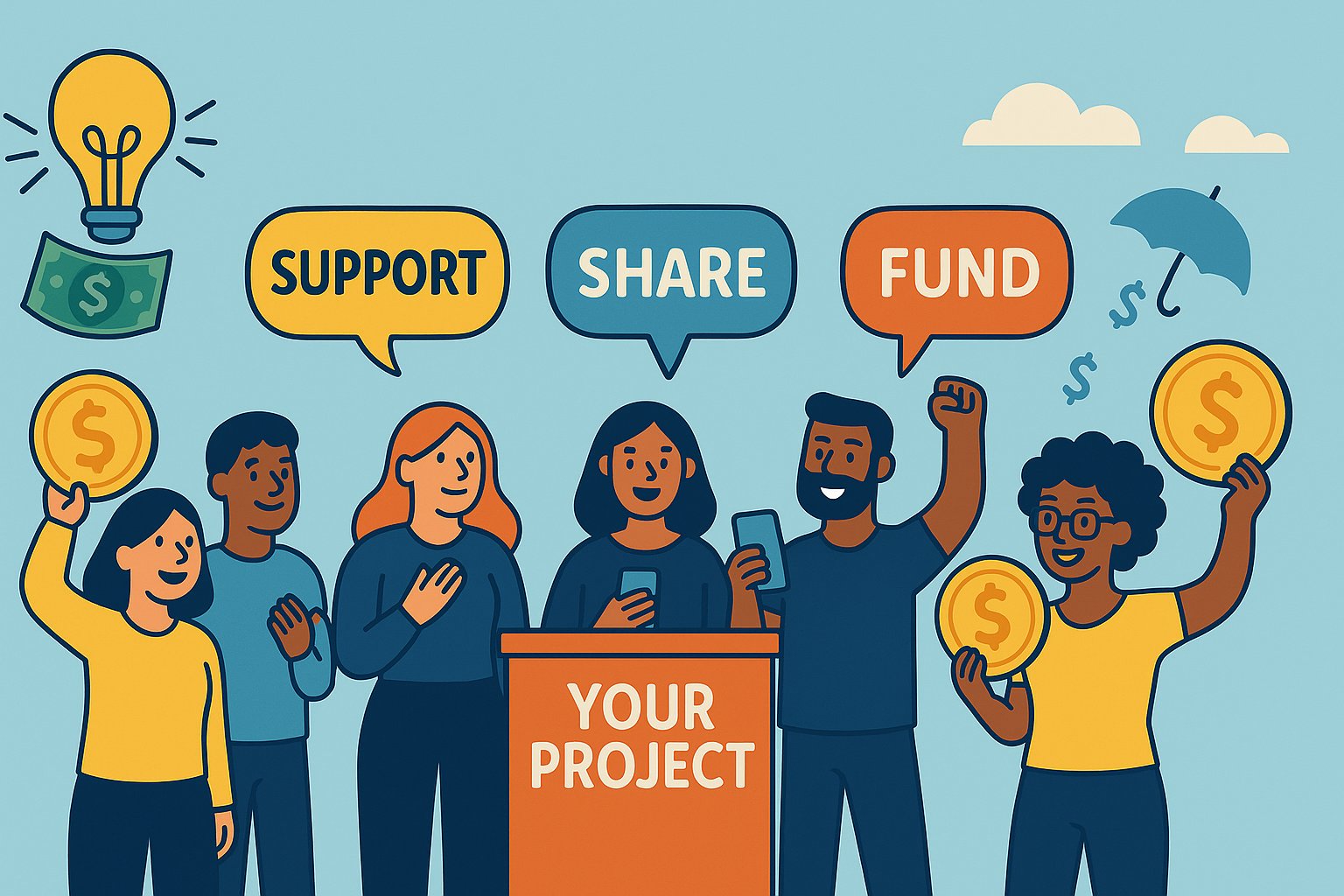Is Crowdfunding Your Golden Ticket?
Standing at the crossroads of ideation and execution, many creators and startups wonder whether crowdfunding is the magic carpet ride that will whisk their dreams into reality. Crowdfunding has captured imaginations by offering an alternative to bank loans and venture capital, letting innovators present their ideas directly to a global audience. Yet, for every viral success story, there are campaigns that fizzle out in obscurity. This guide dives deep into the soul of crowdfunding, helping you decide if rallying a crowd of backers aligns with your vision, resources, and appetite for engagement.
Understanding Crowdfunding: More Than Just Money
At its heart, crowdfunding is a community-driven financing model. Creators pitch a project—whether it’s an inventive gadget, a captivating film, or a social initiative—to potential backers who pledge funds in exchange for rewards, equity, or the satisfaction of contributing to a cause. Platforms like Kickstarter, Indiegogo, and GoFundMe provide the infrastructure: project pages, payment processing, and backer communication tools. Campaigns typically span 30 to 60 days, punctuated by strategic updates, stretch goals, and incentive-driven promotions. Success requires more than a great idea; it demands meticulous planning, narrative flair, and a willingness to nurture every backer relationship.
Is Your Project a Perfect Crowdfunding Candidate?
Not every concept thrives in the crowdfunding arena. Tangible products with clear prototypes and visual appeal tend to attract more pledges, as backers crave a concrete sense of what they’re supporting. Creative endeavors like comics, albums, or independent films also fare well when the creator can share clips or sketches that spark curiosity. Conversely, highly abstract or long-term research projects may struggle to convert interest into financial commitments. Before diving in, ask yourself whether you can showcase your project in a way that resonates emotionally and visually with a broad audience.
Key Eligibility Checklist
Before setting a launch date, run your project through this quick checklist to gauge its crowdfunding readiness:
-
Tangible Deliverable: Can you present a working prototype, mockup, or sample image that backers can envision?
-
Visual Storytelling Assets: Do you have high-quality images and video content ready to dramatize your concept?
-
Engaged Network: Have you cultivated an email list or social media following interested in your niche?
-
Time Commitment: Can you dedicate weeks to pre-launch promotion, daily campaign management, and post-launch updates?
-
Production and Fulfillment Plan: Have you mapped out manufacturing timelines, shipping logistics, and associated costs?
Assessing Your Audience: Building Your Launchpad
Your personal network often provides the initial burst of support that algorithms and external backers notice. Engaged followers on social media, previous customers, or subscribers to your newsletter are your crowdfunding cheerleaders. Cultivate this audience well before launch by sharing sneak peeks, behind-the-scenes stories, or prototype feedback requests. Genuine engagement in relevant online communities—forums, Facebook groups, or niche subreddits—can also surface passionate early backers who will amplify your campaign’s reach.
Financial Considerations: Crafting a Realistic Budget
A compelling campaign page can attract pledges, but without a solid budget, you risk running out of funds before fulfilling rewards. Begin with a bottom-up calculation: prototype development, tooling costs, manufacturing per unit, packaging materials, shipping, taxes, platform fees, and payment processing charges. Add a contingency buffer—typically 10 to 20 percent—to account for unexpected expenses like currency fluctuations or shipping surcharges. Your funding goal should cover these costs and include a margin to invest in marketing or product iteration post-campaign. Transparency in your budget breakdown builds backer trust and demonstrates that you’ve done your homework.
Storytelling and Narrative: Captivate the Crowd
The emotional core of a successful crowdfunding campaign lies in its story. Open with a personal anecdote that explains why this project matters to you—perhaps a childhood spark, a professional “aha” moment, or a community need you witnessed firsthand. Use high-definition video to mix interviews, prototype demonstrations, and user testimonials. Complement the footage with professional photographs showcasing different angles, use-case scenarios, or detailed infographics. Weave in project milestones—research phases, beta tests, or design sketches—to give backers a sense of progress and shared ownership. A narrative that balances personal passion with clear, benefit-driven messaging transforms visitors into invested advocates.
Marketing and Promotion: Igniting Momentum
Even the most polished campaign page can remain invisible without strategic marketing. Pre-launch, build an email list through a “coming soon” landing page offering exclusive updates to subscribers. Reach out to bloggers, podcasters, and influencers in your industry with personalized pitches and early access to prototypes. Once live, coordinate a multi-channel outreach: personalized email blasts, targeted social media ads, and organic posts tailored to each platform’s audience. Leverage social proof by celebrating early milestones—first 100 backers, 50 percent funded—and share user-generated content to highlight community enthusiasm. Monitor analytics daily to identify top-performing channels and adjust your promotional budget accordingly.
Engaging Backers: Communication as the Cornerstone
Transparency and responsiveness distinguish thriving campaigns from forgotten ones. Post regular updates—weekly minimum—that celebrate achievements, disclose challenges, and unveil new stretch goals or bonus rewards. Invite backer input through polls or surveys to foster a sense of collaboration: perhaps allowing contributors to vote on a color variant or name a product feature. Address backer questions and concerns promptly in comments or direct messages. When unexpected delays occur, communicate revised timelines, explain causes, and offer small goodwill gestures like digital wallpapers or discount codes for future purchases. Authentic, two-way communication cements trust and keeps enthusiasm high.
Reward Fulfillment: Delivering on Promises
The post-campaign phase can make or break your reputation. Begin by collecting backer information through surveys that confirm shipping addresses and reward preferences. Finalize agreements with manufacturers and fulfillment partners, verifying production schedules and quality-control protocols. Budget for packaging materials—consider eco-friendly options that align with modern consumer values—and calculate customs fees for international shipments. Provide milestone updates—“Production Completed,” “Rewards En Route”—and share tracking information once available. If delays arise, inform backers immediately and offer apologies along with bonus digital content. On-time, high-quality fulfillment transforms crowdfunding backers into lifelong brand advocates.
Measuring Success: Beyond Dollar Figures
While funding goals are an obvious metric, other indicators signal a campaign’s health and your brand’s future potential. Conversion rates—the percentage of page visitors who become backers—reflect the persuasive power of your page. Average pledge size reveals whether reward tiers are optimally priced. Geographic distribution informs targeted marketing and potential localized launches. Engagement metrics—comments, shares, and update open rates—demonstrate community involvement. Post-campaign, track website traffic spikes, email list growth, and social media following increases to gauge long-term brand impact. These insights guide future product iterations, marketing strategies, and potential follow-up crowdfunding initiatives.
Alternative Funding Paths: Comparing Your Options
Crowdfunding excels at community-driven, reward-based models, but other financing routes may suit your project better. Bootstrapping through personal savings or revenue reinvestment preserves full equity yet limits scaling speed. Angel investors and venture capitalists offer substantial capital plus mentorship but often require relinquishing governance control. Small business loans deliver predictable repayment terms but hinge on creditworthiness and collateral. Grants and sponsorships can provide non-dilutive funding for research, social impact, or creative arts, though they’re competitive and time-intensive to secure. Hybrid approaches—combining modest crowdfunding with a targeted grant application or smaller angel round—can balance community engagement with strategic capital infusion.
Final Decision: Weighing the Pros and Cons
Ultimately, whether crowdfunding is right for you depends on your project’s nature, your resources, and your personal bandwidth. Crowdfunding shines when you have a tangible prototype, compelling visuals, and an engaged network ready to champion your vision. It demands significant pre-launch marketing, daily campaign management, and meticulous fulfillment planning. If you thrive on public engagement, possess compelling storytelling skills, and relish the idea of forging a community around your project, crowdfunding can be transformative. If, however, you lack visual assets, have limited time for promotion, or need rapid capital without the overhead of backer communication, more traditional funding avenues may better serve your objectives.
Chart Your Course with Confidence
Crowdfunding represents more than a fundraising mechanism—it’s an invitation to co-create, collaborate, and amplify your vision with a global community of supporters. By carefully assessing your project’s crowdfunding readiness, crafting a transparent budget, developing an authentic narrative, and executing strategic promotion and communication plans, you position yourself for success. Whether you decide to embrace the crowd or pursue alternative finance, the insights in this guide will sharpen your decision-making and empower you to navigate the complex funding landscape confidently. Now, reflect on your goals, evaluate your resources, and chart the funding path that best aligns with your aspirations—your next breakthrough awaits.




